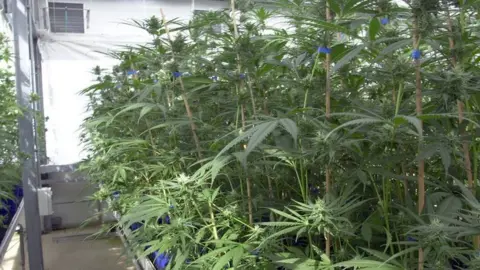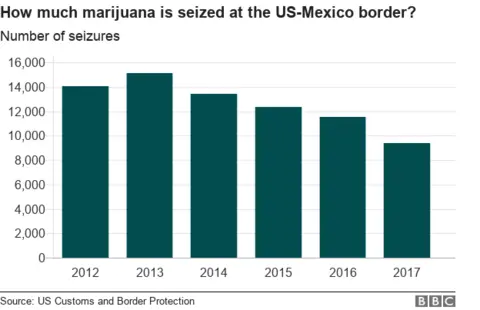Cannabis legalisation: Are there more young users in the US?
 BBC
BBCClaim: The legalisation of cannabis by some US states has led to increased usage, particularly among young people.
Reality Check verdict: There is no clear trend for increased usage by those 17 years or younger - but there are some signs of more usage by young adults.
In the UK, the debate about cannabis was reopened by senior Tory politician Lord Hague, who said the government should consider legalisation.
US drugs policy expert Kevin Sabet, a former White House adviser and opponent of legalisation, told the BBC that in the US the illegal market for cannabis was flourishing in states where the drug had been legalised.
"It's going on the illegal market. It's being sold to youngsters. It's being sold across state lines," he said.
Mr Sabet is president of Smart Approaches to Marijuana (Sam), which says that it wants reforms that discourage marijuana use without resorting to criminal penalties.
"Marijuana" refers to the dried leaves and flowers of the cannabis plant.
Impact on young people
A key concern is what is happening to usage among the young. In states where recreational use is permitted, there is an age limit of 21 years.
Mr Sabet points to survey data indicating higher cannabis usage than the national average for 12- to 17-year-olds in Colorado, Washington, Oregon, Alaska and Washington DC after they legalised the drug.
If you take Colorado and Oregon as examples, there is an increase around the time of legalisation, between 2012 and 2014. But by 2016, the figures appear to have levelled off slightly - although they still remain higher than the national average.
Usage in a number of these states has always been relatively high compared with the national average, even before legalisation for recreational use, going by US government survey data .
It's important to add that among 18- to 25-year-olds, usage does grow in these states after legalisation. What proportion are under the legal age of 21 is not clear.

A Washington State report in early 2016 on the impact of legalisation in 2012 looked at usage in the past month and noted that "between 2006 and 2014 use among 12th Graders [17- to 18-year-olds] increased by an average of 3% per year".
But the report found no such trends of increasing usage among younger age groups.
In January 2017, Colorado's Department of Public Health also looked at usage in the past month, and concluded: "Past-month marijuana use among adults and adolescents has not changed since legalisation either in terms of the number of people using or the frequency of use."
This highlights an issue about data as far as public health is concerned, according to Beau Kilmer, co-director of the Rand Drug Policy Research Center.
"With the data we currently have, you could probably tell whatever story you want depending on the measure and time period you look at," he says.
He says measuring usage in the past month includes people using every day and someone who may have used just once three weeks earlier. And he warns against drawing firm conclusions from such studies.
Mr Kilmer would like to see different figures for consumption, including both frequency of use and total amounts consumed, to build up a more accurate picture of possible trends.
Federal and state picture
A total of 32 states in the US now allow the use of marijuana for medical purposes.
Currently, only ten states (as well as Washington DC) have also legalised marijuana for recreational use, subject to state-level regulations about growing and selling the drug.
Across the US, marijuana trafficking arrests (for selling or distributing the drug in violation of bans or restrictions) are falling, according to the US government's own figures .
Seizures at the border with Mexico have also been going down, something the US Drug Enforcement Agency (DEA) told the BBC was "a reflection of the availability of higher quality, legal cannabis in the US".
 Getty Images
Getty ImagesIn the states where cannabis is legal both for recreational and medical use, production of cannabis has taken off.
Washington state legalised cannabis for recreational use in 2012. In 2017, the outdoor cannabis harvest there was reported to be the largest in history, leading to suggestions that the surplus may be going to other parts of the US where it's still illegal.
In Oregon, which legalised recreational use in November 2014, a report last year by the state police talked of large amounts being diverted to other parts of the US.
Allow X content?
The 2017 harvest in Colorado's major cannabis-growing area was also reported to be one of the biggest after legalisation in 2012.
Official figures from Colorado show that the number of arrests for marijuana-related offences saw an overall increase of more than 60% between 2013 and 2017.
DEA data shows seizures of cannabis went up in some but not all of the legalised states between 2013 and 2017. However, differences in terms of state law enforcement effort and the ability of illicit producers to hide their activities makes exact comparisons difficult.
Chris Walsh, vice-president and founding editor of the trade journal Marijuana Business Daily, says legalisation has led to both individuals and organisations moving in to profit.
"There are issues. And one is that you have got some people abusing the system. You can grow some cannabis at home and then ship it to sell across the state border."
However, he points out that there has always been a large black market in the US and that as legalisation is relatively recent in some states, the authorities are still working out the best ways to regulate and control the growing and sale of cannabis.



